Paleontology
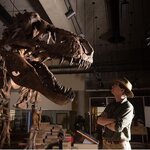
The largest Tyrannosaurus rex skeleton discovered so far, and therefore the largest carnivore on land currently known to science, was discovered in 1991 in Saskatchewan, Canada, but the extremely hard matrix surrounding the bones, in combination with the size of the skeleton of Tyrannosaurus rex (RSM P2523.8), made it especially difficult and time-consuming to remove, assemble, and study.
Since is is relatively complete (roughly 65 percent), RSM P2523.8 has finally been described in The Anatomical Record: Advances in Integrative Anatomy and Evolutionary Biology.
Bone analyses revealed…
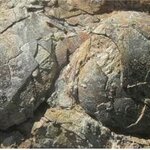
Fossilized eggshells unearthed in western Romania represent the earliest known nest site shared by multiple animals. The shells – some complete and others broken into thousands of pieces – are densely packed and encased in mudstone which formed part of the remains of a bird breeding colony, probably comprising hundreds of seperate nests.
Now in the collections of the Transylvanian Museum Society in Cluj Napoca, Romania, the samples date from the late-Cretaceous period (approx. 70 million years ago) and were discovered near the city of Sebeş in Transylvania by local palaeontologist…

Senckenberg scientist Ingmar Werneburg, together with an international team, re-examined the An examination of the skull structure of Tyrannosaurus rex using “anatomical network analysis” found that the carnivorous dinosaur had an extremely flexible skull structure.
Tyrannosaurus rex – the “King of the Tyrant Lizards” – owes its name in part to its impressive teeth and skull. Researchers compared the skull of T. rex with the skull construction of modern terrestrial vertebrates to examine which skull bones are connected to each other and found that different bone modules led to a highly…

The ichthyosaur (literally ‘fish-lizard’) lived in what is today southern Germany during the Jurassic Period some 180 million years ago. The two-meter long reptile swam in the vast ocean that is now, after climate and geological changes, Europe.
Researchers have analyzed the remains of an ichthyosaur so well-preserved that its soft-tissues retain some of their original pliability; the most comprehensive and in-depth examination of a soft-tissue fossil ever undertaken. Among other things, the study reveals that the soft parts have fossilized so quickly that both the original cells and their…
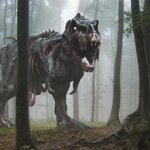
A key part of palaeontology is reconstructing long-extinct creatures to understand what they were like when they were alive. Such knowledge allows us to answer fundamental questions about how they moved and interacted with their environment. How did they feed and reproduce? Which of today's organisms are they most like and most closely related to?
It has challenges. The history of life can be distorted by the ways animals decompose and lose body parts as they decay - and the ways in which decayed bodies ultimately become fossilized. Like on-screen zombies in "The Walking Dead" that…

Einstein could stick out his tongue but dinosaurs could not, according to a new paper. Instead of being like modern day lizards or legendary physicists, their tongues were probably rooted to the bottoms of their mouths like alligators.
The discovery was made by comparing the hyoid bones — the bones that support and ground the tongue — of modern birds and crocodiles with those of their extinct dinosaur relatives. In addition to challenging depictions of dino tongues, the research proposes a connection on the origin of flight and an increase in tongue diversity and mobility.
Hyoid bones…

Pond scums were an animal’s best friend. 540 million years ago, oxygen was scarce in the atmosphere and ocean, and animals needed to find oxygen to make a living. If you think farming is hard now, imagine when it involved first finding enough to breathe.
But that's good for us, because it led scientists to finding the oldest footprints on Earth to-date, 10 million years older than the previous record.
Found in a small chunk of sediment rock in a shallow sea bottom in China, the tiny tracks – millimeters in width – were made by an unknown bug-like creature no bigger than…
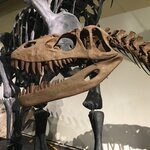
This specimen of the theropod dinosaur Torvosaurus tanneri is on display in Madrid, Spain. The genus Torvosaurus includes a unique species of megalosaurid theropod dinosaur. They are found in the Morrison Formation, western United States but spread widely with specimens of the same species being unearthed in Europe in the Lourinha Formation near Lisbon, Portugal.
Torvosaurus were one of the largest and most robust carnivores of the Jurassic. These "savage lizards" were true to their name. Skilled hunters, who could grow from 9 to ll meters long, weigh over 2 tons, were bipedal with powerful…
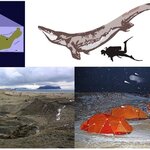
Kaikaifilu is a new species of giant sea lizard (mosasaur) discovered in 66 million year-old rocks of Antarctica. At about 10 m long, it is the largest known top marine predator from this continent. It lived near the end of the dinosaur age, when Antarctica was a much warmer ecosystem, and fed on filter-feeding marine reptiles.
Because of its harsh conditions, Antarctica is probably one of the toughest places to work for palaeontologists. However, precisely because of this, information is scarce, and new discoveries can be highly rewarding. In 2010, an expedition of Chilean scientists to…

Thanks, but no thanks, say British scientists about controversial British evolutionary biologist Richard Dawkins, primarily known for his criticism of religion.
A majority of those surveyed who mentioned Dawkins’ work during research interviews reject his approach to public engagement and said his work misrepresents science and scientists because he conveys the wrong impression about what science can do and the norms that scientists observe in their work.
The Religion Among Scientists in International Context (RASIC) study includes a survey of over 20,000 scientists from eight countries. In…